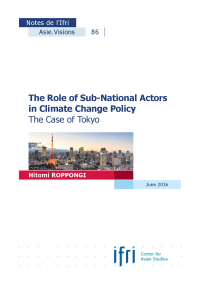Gateway to Think Tanks
| 来源类型 | Publications - Policy Papers - Asie Visions |
| 规范类型 | 简报 |
| The Role of Sub-National Actors in Climate Change Policy. The Case of Tokyo Asie.Visions 86, June 2016 | |
| Hitomi ROPPONGI | |
| 发表日期 | 2016-06-10 |
| 出处 | Asie Visions |
| 出版年 | 2016 |
| 概述 | Tokyo is known as a pioneer throughout the history of Japan’s environmental policy, often being compared to California in the United States or Paris in France. Following the global trend of growing local initiatives tackling climate change, Tokyo introduced a cap-and-trade scheme in 2010 ahead... |
| 摘要 |
The Role of Sub-National Actors in Climate Change Policy. The Case of Tokyo Asie.Visions 86, June 2016
Tokyo is known as a pioneer throughout the history of Japan’s environmental policy, often being compared to California in the United States or Paris in France. Following the global trend of growing local initiatives tackling climate change, Tokyo introduced a cap-and-trade scheme in 2010 ahead of a national implementation.  The Tokyo Cap-and-Trade Program is the first of its kind that regulates CO2 emissions from all business sectors, where energy consumers are defined in terms of the business establishments they own. Tokyo’s initiative is largely seen as a reaction to the modest national commitment, following the tradition of center-local rivalry. This study first explains the centre-local relationship in the history of Japan’s environmental governance. It then analyzes the development of the Tokyo’s flagship climate policy and its implications for national and other sub-national governments in Japan. The tactics used by the Tokyo Metropolitan Government to overcome business opposition typically seen in the introduction of GHG control, and future policy challenges are also discussed. The study finds that Tokyo’s policy encourages behavioral changes and technological improvement in the business sector, going a step beyond the existing culture of energy conservation in Japan. An emission trading scheme is often associated with the collapse of carbon markets and the “money game”, rather than a practical tool to reduce CO2 emissions, but the Tokyo Cap-and-Trade Program has demonstrated a policy impact that recasts such an image. A known case of policy diffusion to Saitama prefecture, an immediate neighbor of Tokyo with the fifth largest population in Japan, is also discussed to elaborate on the potential domestic diffusion of the policy.
The Role of Sub-National Actors in Climate Change Policy. The Case of Tokyo
|
| 关键词 | Energy climate change Environment carbon market Energy - Climate city Asia Japan Tokyo |
| URL | https://www.ifri.org/en/publications/notes-de-lifri/asie-visions/role-sub-national-actors-climate-change-policy-case-tokyo |
| 来源智库 | French Institute of International Relations (France) |
| 资源类型 | 智库出版物 |
| 条目标识符 | http://119.78.100.153/handle/2XGU8XDN/416187 |
| 推荐引用方式 GB/T 7714 | Hitomi ROPPONGI. The Role of Sub-National Actors in Climate Change Policy. The Case of Tokyo Asie.Visions 86, June 2016. 2016. |
| 条目包含的文件 | ||||||
| 文件名称/大小 | 资源类型 | 版本类型 | 开放类型 | 使用许可 | ||
| av_86_en_db_ok_prote(29KB) | 智库出版物 | 限制开放 | CC BY-NC-SA |  浏览 | ||
| av_86_en_db_ok_prote(1204KB) | 智库出版物 | 限制开放 | CC BY-NC-SA | 浏览 | ||
除非特别说明,本系统中所有内容都受版权保护,并保留所有权利。